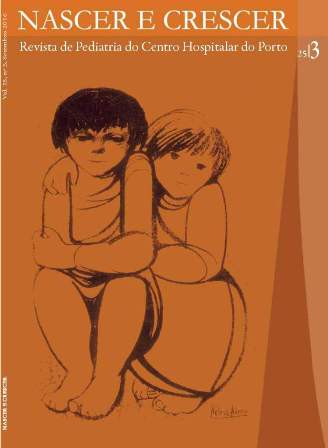REASONS TO ACCESS TO A PEDIATRIC EMERGENCY DEPARTMENT
DOI:
https://doi.org/10.25753/BirthGrowthMJ.v25.i3.10075Keywords:
emergency service, pediatrics, societyAbstract
Introduction: Hospital emergency department (ED) utilization by non-urgent situations is common and leads to worse care, patients and professionals dissatisfaction and increasing costs.
Objective: To determine the reasons and adequacy for the use of a hospital pediatric ED. Methods: Descriptive, cross-sectional study between October 10 and December 31 2013 at an hospital pediatric ED, through analysis of questionnaires completed by child caretakers and with clinical data provided by the doctor who observed the child.
Results: There were 481 validated and analised questionnaires. ED use within the first 24 hours of disease was observed in 48%. The main reasons were: notion of a serious and urgent disease (33%), being the nearest facility (17%), preference for evaluation by a pediatrician (17%). Most were discharged without any additional diagnostic test or specific treatment (89%) and the main discharge diagnosis were acute nasopharyngitis and gastroenteritis. Only 19.7% of ED episodes were considered as “justified” by the WHO criteria for hospital emergency or by referral from another health institution. There are no differences between children who used pediatric ED in a “justified” or “unjustified” way.
Discussion and conclusion: Recognition of clinical situations that justify the hospital ED use seems unrelated to parental education or primary care doctor assignment. The notion of serious illness in low-severity situations with early and fast access to a tertiary health care facility reveals lack of information on health concepts by the general population.
Downloads
References
Direcção-Geral da Saúde – Direcção de serviços de planeamento. Rede de referenciação hospitalar de urgência/emergência. Lisboa: Direcção-Geral da Saúde 2001.
OMS. Planification et organisation des services médicaux d’urgence – rapport sur la réunion d’un groupe tecnique de l’OMS. Toulouse, 24-28 février 1979. Raport et etudes Euro 95. Boureau Régional de l’Europe, Copenhague: OMS, 1981.
Caldeira T, Santos G, Pontes E, Dourado R, Rodrigues L. O dia-a-dia de uma urgência pediátrica. Acta Pediatr Port 2006; 1(37): 1-4.
Costa V, França-Santos K, Trindade E, Mota T, Clemente F, Carreiro E, et al. Avaliação dos motivos de vinda ao serviço de urgência. Acta Pediatr Port 1997; 5(28): 411-7.
Vedovetto A, Soriani N, Merlo E, Gregori D. The burden of inappropriate emergency department pediatric visits: why italy needs an urgente reform. Health Serv Res 2014; 49(4): 1290-305.
Vinelli N, Mannucci C, Laba N, Vecchio L, Valerio A, Lago M, et al. Consultas no urgentes al departamento de urgências de un hospital pediátrico. Arch Argent Pediatr 2011; 109(1): 8-13.
Chin N, Goepp J, Malia T, Harris L, Poordabbagh A. Nonurgent use of a pediatric emergency department: a preliminar qualitative study. Pediatr Emerg Care 2006; 22(1): 22-7.
Zimmer K, Walker A, Minkovitz C. Epidemiology of pediatric emergency department use at an urban medical center. Pediatr Emerg Care 2005; 21(2): 84-9.
Derlet R, Richards J. Overcrowding in the nation’s emergency departments: complex causes and disturbing effects. Ann Emerg Med 2000; 35: 63-8.
Barroso M, Ferreira G, Machado M, Lemos P. Referenciação pediátrica – que realidade? Acta Pediatr Port 2003; 2(34): 89-93.
Kubicek K, Liu D, Beaudin C, Supan J, Weiss G, Lu Y, et al. A profile of nonurgent emergency department use in an urban pediatric hospital. Pediatr Emerg Care 2012; 28(19): 977-84.
Administração Regional de Saúde do Norte. Urgência Pediátrica Integrada do Porto – a construção de um projecto. 1ª edição, Porto.
Herman A, Young K, Espitia D, Fu N, Farshidi A. Impact of health literacy intervention on pediatric emergency department use. Pediatr Emerg Care 2009; 25(7): 434-8.
Downloads
Published
How to Cite
Issue
Section
License
Copyright and Authors' Rights
All articles published in Nascer e Crescer - Birth and Growth Medical Journal are Open Access and comply with the requirements of funding agencies or academic institutions. For use by third parties, Nascer e Crescer - Birth and Growth Medical Journal adheres to the terms of the Creative Commons License "Attribution - Non-Commercial Use (CC-BY-NC)".
It is the author's responsibility to obtain permission to reproduce figures, tables, etc. from other publications.
Authors must submit a Conflict of Interest statement and an Authorship Form with the submission of the article. An e-mail will be sent to the corresponding author confirming receipt of the manuscript.
Authors are permitted to make their articles available in repositories at their home institutions, provided that they always indicate where the articles were published and adhere to the terms of the Creative Commons license.


